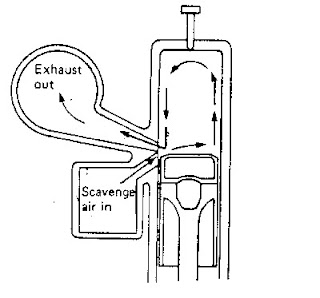MARINESHELF publishes articles contributed by seafarers and other marine related sites solely for the benefit of seafarers .All copyright materials are owned by its respective authors or publishers.
Loop
Scavenging.
Most loop scavenge engines have the air inlet ports and
exhaust ports around the periphery of lower end of liner, exhaust ports being
on top of inlet ports. The air is admitted in the transverse plane across the
piston and is forced to leave through exhaust ports. In some engines inlet ports in the liner are
either level with, or higher than, the exhaust ports. In these engines, automatically operated
non-return scavenge valves are in the air manifold, to prevent the exhaust gas
from contaminating the fresh air charge. If the air inlet ports are lower than
the exhaust ports the scavenge valve could be dispensed with, but the engine
output might be reduced by 20 to 30%. With proper designing of ports, very
efficient scavenging up to 90% can be obtained.
Advantages:
- Simplicity.
- Reliability.
- Less maintenance.
- Simplification of cylinder cover enabling it to sustain high thermal stresses and enabling optimum combustion space design and high efficiency.
Disadvantages:
- The temperature gradient, exhaust to scavenge, tends to cause piston and liner distortion. The cure is to have adequate water-cooling.
- The exhaust gases can enter the crankcase (or under piston space) at certain piston positions due to piston clearance and efficient sealing rings, reducing the cleanliness of the engine.
- Carbonisation of exhaust ports and pipes takes place, because it is not possible to prevent oil from passing through parts, but reduction of lubricating oil consumption to the minimum adequate exhaust port cooling is beneficial.
- Uneven piston ring wear occurs, but the use of round or approximately round ports can reduce the wear.
- Scavenging efficiency is somewhat lower than with uniflow system due to the more complex gas-air interchange and the possibility of change air passing straight to exhaust with little or no scavenging effect. Careful port designing can considerably reduce this problem.

No comments:
Post a Comment